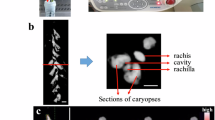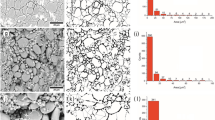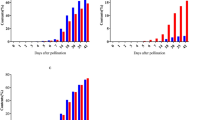Abstract
AT the Liverpool meeting of the British Association in 1923, it was shown that polarized radiation had the effect of accelerating the change of starch grains, in a weak suspension of diastase and at ordinary laboratory temperature, into a crystalline reducing substance ; but if the diastase were active or concentrated, no selective effect was observed1. Earlier experiments in 1922 had shown me that, when ground cereals in plain tap water were exposed to this radiation, a portion of the starch was turned to sugar. This was estimated by Bertrand's method2. To meet criticism that the effect might be due to the pressure of the cover glass, the experiment was repeated ; but instead of using a microscope slide, the starch suspension was in a flat-bottomed, very thin-walled flask, the base of which was irradiated by light, polarized and reflected vertically upward by a suspension of diastase in an outer vessel3.
This is a preview of subscription content, access via your institution
Access options
Subscribe to this journal
Receive 51 print issues and online access
$199.00 per year
only $3.90 per issue
Buy this article
- Purchase on SpringerLink
- Instant access to full article PDF
Prices may be subject to local taxes which are calculated during checkout
Similar content being viewed by others
References
Nature, 111, 49 ( 1923).
Chemistry and Industry ( Oct. 5, 1923). Baly and Semmens, Proc. Roy. Soc., B, 97, 250 ( 1924). Nature, 134, 813 ( 1934).
Nature, 117, 821 ( 1926); J. Brit. Assoc., 13 (Oxford meeting, 1926).
Author information
Authors and Affiliations
Rights and permissions
About this article
Cite this article
SEMMENS, E. Hydrolysis of Starch Grains by Polarized Infra-Red Radiation. Nature 163, 371 (1949). https://doi.org/10.1038/163371a0
Issue date:
DOI: https://doi.org/10.1038/163371a0



